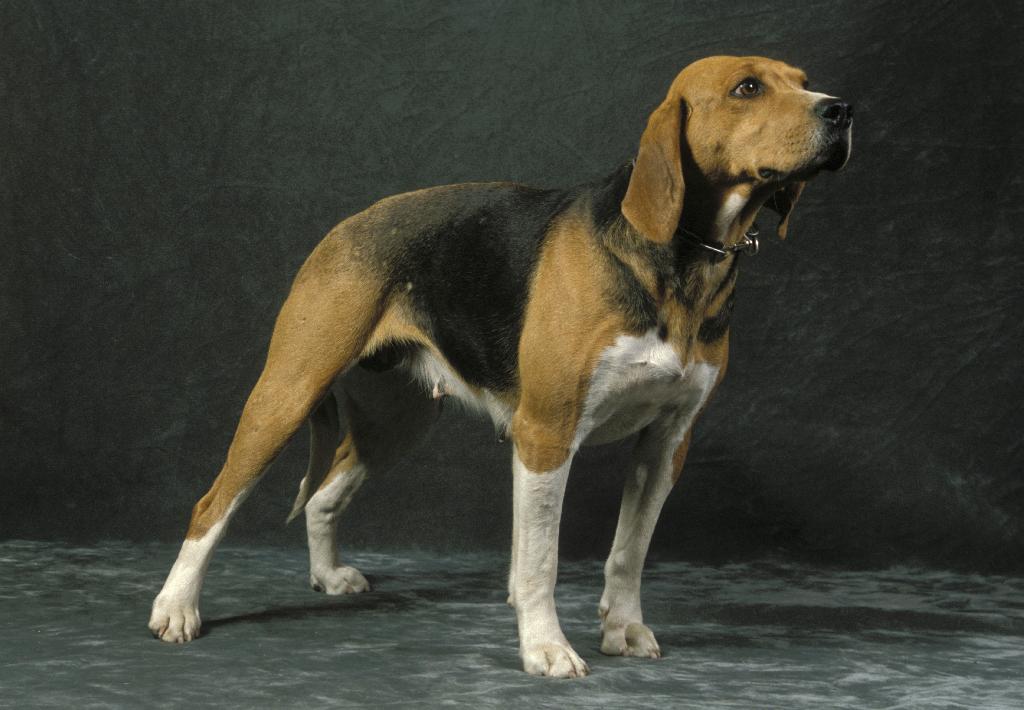Harrier

Description
The Harrier is a medium-sized breed of hound that is primarily known for its excellent scenting abilities and its history as a hunting dog. Often described as a smaller version of the English Foxhound, the Harrier was developed in England for hunting hares and other small game. This breed has ancient roots, with records suggesting that the Harrier's ancestors date back as far as the 13th century. They were bred to be pack dogs, working in teams to track and chase game over long distances, using their keen sense of smell to follow a trail. Their endurance, speed, and ability to work in the field make them ideal for hunting.
Physically, the Harrier is a well-proportioned, athletic dog with a strong and muscular build. It typically stands between 18 and 22 inches tall at the shoulder and weighs around 40 to 60 pounds. The breed has a short, dense coat that is weather-resistant, often in a variety of colors, including tri-color (black, tan, and white) or bi-color patterns. Harriers have a long, straight tail, which they hold high when alert or on the trail. Their ears are medium-sized, set low, and their eyes are usually dark and expressive, contributing to the breed's overall alert and energetic appearance.
Harriers are known for their exceptional scenting ability, which is why they have been so successful as hunting dogs. Their stamina and determination allow them to track game over long distances, and they are highly skilled at working in packs. Despite their hunting instincts, Harriers are generally friendly, social dogs that get along well with people and other dogs. They are not aggressive by nature but can be independent and stubborn due to their strong hunting drive. Early training and socialization are important for the Harrier, as they need to learn basic commands and how to be well-behaved in a home setting.
As a breed, the Harrier is energetic and needs a lot of exercise to remain happy and healthy. They are best suited for active families or individuals who can provide them with plenty of outdoor activities, such as running, hiking, or engaging in dog sports like agility. While they can make great pets, Harriers are not ideal for apartment living or small homes due to their need for space and regular exercise. Without enough physical and mental stimulation, they can become bored and may resort to destructive behaviors.
In conclusion, the Harrier is a lively, intelligent, and hardworking breed that excels in scenting and endurance. Its strong hunting instincts make it an excellent choice for those who enjoy outdoor activities or hunting, but its friendly and social nature also makes it a good companion for the right home. With proper exercise, training, and mental stimulation, the Harrier can thrive as both a working dog and a loyal family pet.
History
The Harrier is a medium-sized scent hound with a rich history that dates back several centuries in England. Originally bred for hunting hares, the Harrier's name is derived from the word “hare.” The breed is believed to have been developed in the 13th century, making it one of the oldest scent hound breeds. Its ancestry likely includes the Talbot Hound, which was brought to England by the Normans, as well as early forms of the Bloodhound and Basset Hound. These influences resulted in a hound with exceptional scenting abilities, stamina, and determination.
During the medieval period, the Harrier was a favorite among hunters who preferred to follow their hounds on foot rather than on horseback. Its steady pace, keen nose, and ability to track game over long distances made it an ideal choice for hare hunting. By the 18th and 19th centuries, organized Harrier packs became common across England, with detailed records kept by hunters who prized the breed’s performance. The Harrier’s versatility also allowed it to adapt to hunting foxes when required, further solidifying its reputation as a reliable and adaptable hound.
Despite its popularity in England, the Harrier has remained less well-known than its larger relative, the Foxhound. The breed was introduced to the United States during the colonial period, where it was similarly valued for its hunting prowess. The American Kennel Club (AKC) officially recognized the Harrier in 1885, although it remains a rare breed in the U.S. compared to other scent hounds.
Today, the Harrier continues to excel in its traditional role as a pack hound for hunting hares and foxes, while also finding a place as a loyal and energetic companion in active households. Its history reflects the breed’s enduring appeal as a hardworking and determined dog, capable of combining athleticism with an even temperament and a friendly nature.
Colors
• Black White & Tan
• Lemon & White
• Red & White
• Tricolored


